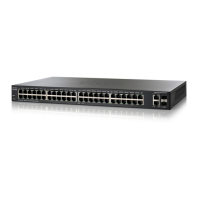System Time
Adding an SNTP Server
Cisco Small Business 200 1.1 Series Smart Switch Administration Guide 40
5
-
In Process
—Occurs when the SNTP server has not fully trusted it's own
time server (i.e. when first booting up the NTP server).
• Last Response—Date and time of the last time a response was received
from this SNTP server.
• Offset—The estimated offset of the server's clock relative to the local clock,
in milliseconds. The host determines the value of this offset using the
algorithm described in RFC 2030.
• Delay—The estimated round-trip delay of the server's clock relative to the
local clock over the network path between them, in milliseconds. The host
determines the value of this delay using the algorithm described in RFC
2030.
• Last Synchronized Server—Appears at the bottom of the other selections,
and displays the address of the SNTP server from which time was last taken.
STEP 2 (Optional) Select SNTP Broadcast Reception > Enable to listen to SNTP
Broadcast synchronization packets for system time information. The system will
only display an SNTP server once a successful broadcast has been received. This
feature is not functional when the switch is in layer 3 mode.
STEP 3 Click Add to display the
Add SNTP Server
page.
STEP 4 Enter the following parameters:
• Server Definition—Select if the SNTP server is going to be identified by its
IP address or if you are going to chose a well-known SNTP server by name
from the list.
NOTE To specify a well-known SNTP server, the switch must be connected
to the Internet and configured with a DNS server or configured so that a DNS
server is identified by using DHCP. (See the Defining DNS Servers section.)
• IP Version—Select the version of the IP address: Version 6 or Version 4.
• IPv6 Address Type—Select the IPv6 address type (if IPv6 is used). The
options are
- Link Local—The IPv6 address uniquely identifies hosts on a single
network link. A link local address has a prefix of FE80, is not routable, and
can be used for communication only on the local network. Only one link
local address is supported. If a link local address exists on the interface,
this entry replaces the address in the configuration.
- Global—The IPv6 address is a global Unicast IPV6 type that is visible and
reachable from other networks.

